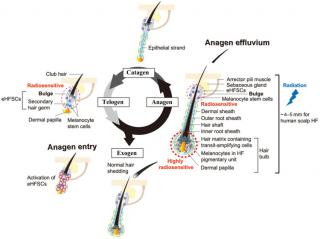Sep, 2023

Because hair follicles (HFs) are highly sensitive to ionizing radiation, radiotherapy-induced alopecia (RIA) is a core adverse effect of oncological radiotherapy. Yet, effective RIA-preventive therapy is unavailable because the underlying pathobiology remains underinvestigated. Aiming to revitalize interest in pathomechanism-tailored RIA management, we describe the clinical RIA spectrum (transient, persistent, progressive alopecia) and our current understanding of RIA pathobiology as an excellent model for studying principles of human organ and stem cell repair, regeneration, and loss. We explain that HFs respond to radiotherapy through two distinct pathways (dystrophic anagen or catagen) and why this makes RIA management so challenging. We discuss the responses of different HF cell populations and extrafollicular cells to radiation, their roles in HF repair and regeneration, and how they might contribute to HF miniaturization or even loss in persistent RIA. Finally, we highlight the potential of targeting p53-, Wnt-, mTOR-, prostaglandin E2-, FGF7-, peroxisome proliferator-activated receptor-γ-, and melatonin-associated pathways in future RIA management.